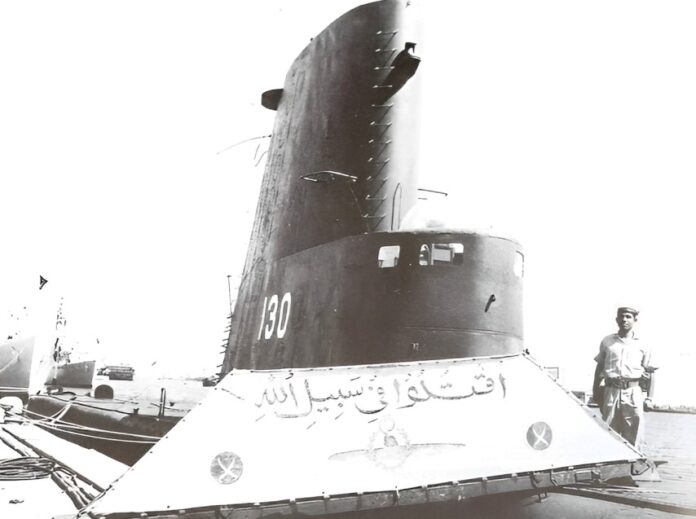“India has aggressed and is waging an all-out war against Pakistan. Our brave comrades in the Pakistan Army and Pakistan Air Force have already given the enemy a telling answer and inflicted heavy blows. The Nation stands solidly behind the Supreme Commander and the Armed Forces. I call upon all officers and men of the Pakistan Navy to discharge their sacred duty with faith, courage and determination and justify the trust reposed in us. God willing, success will be ours. Pakistan Paindabad”. This was the ‘order of the day’ issued by the Commander-in-Chief Pakistan Navy, Vice Admiral A.R.Khan on 7th September 1965.
No significant activity occurred in the North Arabian Sea on the initial day of the 1965 war. Except for a botched attempt and few scattered bombs dropped along Pakistan’s Makran coast, the first raid by the Indian Air Force on Karachi made no impact. In the meantime, intelligence estimates by Pakistan Navy indicated the disposition of Indian Naval armada. The Indian aircraft carrier INS Vikrant and cruiser INS Delhi were reckoned to be in Bombay harbour, two frigates at Calcutta and cruiser INS Mysore off the Indian East coast heading south on way to reinforce the Indian Fleet along the Western coast. Some smaller Indian Naval escorts were also evaluated to be dispersed along the East and West coast of India. In terms of numerical strength while Pakistan Navy had one cruiser, one submarine and 7 destroyers, Indian Navy outnumbered it by one aircraft carrier, two cruisers and 19 destroyer/frigates. Be that as it may, the impression drawn at the time was that Indian Navy was not ready for a full scale war. What ensued proved this impression emphatically.
On the morning of the 7th September Pakistan Navy decided that the time is opportune to conduct a major operation along the west coast of India. An operation codenamed ‘Somnath’ which aimed to target port of Dwarka on the Kutch coast was accordingly planned. This port had an airborne early warning radar station. It also housed a bomber guidance beacon that beamed on Karachi and was used by the Indian Air Force to direct bombers. An additional reason in selecting Dwarka for pounding was to draw out the Indian Naval forces especially, large combatants like INS Vikrant and cruiser INS Mysore which could thus fall prey to the fearsome predator, PN submarine Ghazi, by then patrolling off Bombay. As luck would have it, PAF carried out a strike on the neighboring Indian airbase at Jamnagar on the 6th of September. From all accounts the raid by PAF was a success and as such not much enemy air activity was anticipated during operation ‘Somanth’.
At 0024 hours past midnight on September 8, a formation of six Pakistan Navy destroyers accompanied by cruiser PNS Babur unleashed their deadly arsenal on the pre-selected target roughly 6 miles from the Indian coast. Each ship spewed 50 rounds of ammunition from its main guns to reduce the target to rubble. By 0028 (within four minutes) the operation was over without the slightest resistance. Owing to the swiftness and professional manner in which it was executed, operation ‘Somnath’ became a trend setter- a precedent which continues to inspire the newer generation of naval officers to this day. In the subsequent days and till the termination of the war, Pakistan Navy held an uncontested supremacy in the North Arabian Sea with Indian Navy nowhere in sight. Following ceasefire, the then President of Pakistan commended Pakistan Navy in the following words: “Pakistan Navy has played a tremendous role in keeping the much larger Navy of the enemy away from our shores”.

Why did such a large Indian Navy with an overwhelming numerical superiority failed so embarrassingly as to be almost invisible in the war theatre against a small adversary? The answer is provided by a prominent scholar and associate Professor Harsh V. Pant of the Defence Studies Department, King’s College London in a recent work. He notes, “Despite a general understanding among Indian political elites that it was the littoral dominance by the European powers that led to their colonial ascendancy in the Indian heartland, the focus on land frontiers led to the dominance of the Indian Army in the national security discourse. Until the end of the Cold War, the maritime dimension of India’s security did not figure adequately in the national consciousness. Indian policy makers did not perceive the advantage of building up the nation’s maritime sinews as the country remained concerned with the north and north western frontiers after partition rather than with her sea frontiers”.
Forty eight years later, Indian Navy’s original local sea control and shore defence orientation, which largely focused on preserving the integrity of Indian coastal waters from regional threats, has given way to an ambitious naval posture. Thanks to the Indian strategic community. A definitive recognition of its role in advancing India’s economic, security and regional interests has provided Indian Navy with a proverbial and much needed ‘shot in the arm’. Since the end of cold war, successive Indian governments have made mammoth investments in the service. The Indian Navy is the only service amongst the three which has seen a whopping seventy-five percent increase in its share of defence budget this year. It is investing close to USD 3 bn for expanding littoral warfare potential and has already inducted two nuclear submarines in its fleet. By 2020, Indian Navy contemplates fielding three aircraft carriers. This underlines the rapidly transforming mindset of the Indian strategic establishment.
Pakistan Navy, despite a paltry share of roughly 10 percent in the national defence budget has however not been far behind. The understanding on Navy and naval related issues amongst Pakistan’s strategic is today far better than it was during the cold war. And Pakistan Navy has undergone a metamorphosis over the past decade to turn into a potent regional force. With a newly articulated Vision and ‘Core values’ and powered by a professionally competent manpower, Pakistan Navy has now largely indigenized its hardware and managed to induct several major as well as minor platforms in its inventory in the recent years. The firepower and strategic dimension of Pakistan Navy service has also been ascending swiftly. A 200km plus land attack missile was recently test fired with pinpoint accuracy while keel was laid for a new Naval Strategic Force Command.
Pakistan Navy has moreover expanded its operations to envelop the entire western Indian Ocean region and now extensively operates with multinational navies over and above UN mandated task forces. It regularly holds a wide ranging exercise, AMAN involving dozens of regional and extra regional navies. All in all, Pakistan Navy is a formidable force with adequate potential to project power at sea and influence events. Concurrently, it holds promise to protect national maritime interests both, in peace as well as war.




